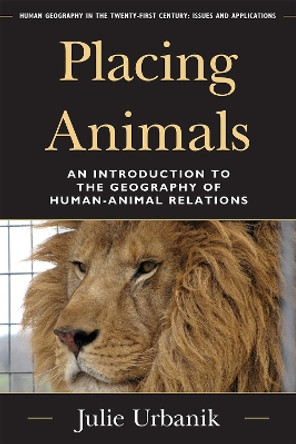Description
About the Author
Julie Urbanik is assistant teaching professor in the Department of Geosciences at the University of Missouri-Kansas City.
Reviews
It is not often that a text is seminal, but this one is. Urbanik reviews the geographic research that deals with humans' relationships with animals and provides an effective framework to understand how geographic thought has developed on this topic. She provides a historical overview of thinking about animals in the human world and analyzes recent geographic studies of animals as beasts of burden, on farms as food, and as wildlife in human spaces. Urbanik 'places' animals in societies' historical, economic, cultural, ethical, and political landscapes, and engages students to employ geographical approaches to think about animals in their lives. This introductory text would provide an appropriate foundation for courses designed to consider the geography of human-animal relations. However, it is more than that. It also reveals the evolution of the scholarship that is, of course, valuable to researchers, and captures a snapshot of contemporary attitudes toward and feelings about animals in mainstream cultures. Though rather brief, the book is very readable and deals with rather complex conceptualizations. It is a library-worthy volume, for certain. Summing Up: Essential. All academic levels/libraries. * CHOICE *
Animals interact with us on a daily basis as wildlife, food, clothing, companions, entertainment, and therapy. But although they are everywhere and connected to geographies of everyday human experience, some geographers still refuse to see them. Julie Urbanik's Placing Animals is a remedy for such short-sightedness. As the first book to provide an overview of new animal geography, it clearly shows how human-animal relations have moved from the margins to have a greater disciplinary presence. . . . The style and structure make this an accessible and engaging read for undergraduates. Throughout the book, Urbanik challenges readers to think about the way we understand human-animal relations. . . . The discussion questions and general approach also make this a useful and original guide for teaching. This is an excellent introduction to the subject. It clearly outlines the relevance of human-animal relations to geography, while showing how a geographical approach 'opens plenty of doors in a multitude of directions.' . . . Placing Animals should be regarded as the new foundation for the future of animal geography. * Geographical Review *
Urbanik provides us with an excellent book for teaching animal geographies. Always an innovative and eclectic thinker, Urbanik takes us to the multiple places we inhabit with other animals, encouraging us to think more deeply about these relationships with the help of her imaginative and penetrating vision. I am excited to use this inspiring book for my first animal geographies course. -- Jody Emel, Clark University
Geography plays a pivotal role in shaping the everyday lives and deaths of non-human animals, and conversely, the ways in which animals influence people, economies, and societies. Animals are variously intimate companions, food and clothes, modes of transportation, spare body parts, symbols of wilderness, spiritual guides, and victims of rampant development and climate change. At the same time, they have always been agents of change, altering human ecologies, cultures, histories, and the evolution of our moral compass. Placing Animals seeks to understand these complex relationships in time and space. Arguing that only by pursing a decidedly more-than-human geography can the discipline adequately address nature-society relations, Julie Urbanik has delivered an extraordinarily clear, accessible book that will be welcomed by geographers everywhere who have wondered: Where in the world are all the animals? -- Jennifer Wolch, University of California, Berkeley
Julie Urbanik has authored a thought-provoking and innovative geography of human-animal relations for the twenty-first century. Placing Animals both reformulates animal geography and asserts its significance as an important but oft-neglected field. Whereas traditional animal geographies tended to focus on farming, including both sedentary animal husbandry and nomadic pastoralism, Urbanik takes us into a dominantly urban world, where most people experience animals primarily as food, leather, pets, photographs, film, and backyard wildlife. . . .Placing Animals has many of the currently fashionable features of textbooks, notably a series of thought-provoking insets to the text: profiles of the tiger, the camel, the dog, the donkey, the pig, and the whale and dolphin. . . .Placing Animals will appeal to students willing to debate ideas and confront a wide range of esoteric examples, drawn from across the world. . . .Researchers will find Placing Animals thought-provoking in the range of ideas and issues that it covers. * AAG Review of Books *
Awards
Winner of CHOICE Outstanding Academic Title 2013.
Book Information
ISBN 9781442211858
Author Julie Urbanik
Format Paperback
Page Count 206
Imprint Rowman & Littlefield
Publisher Rowman & Littlefield
Weight(grams) 322g
Dimensions(mm) 230mm * 152mm * 13mm








